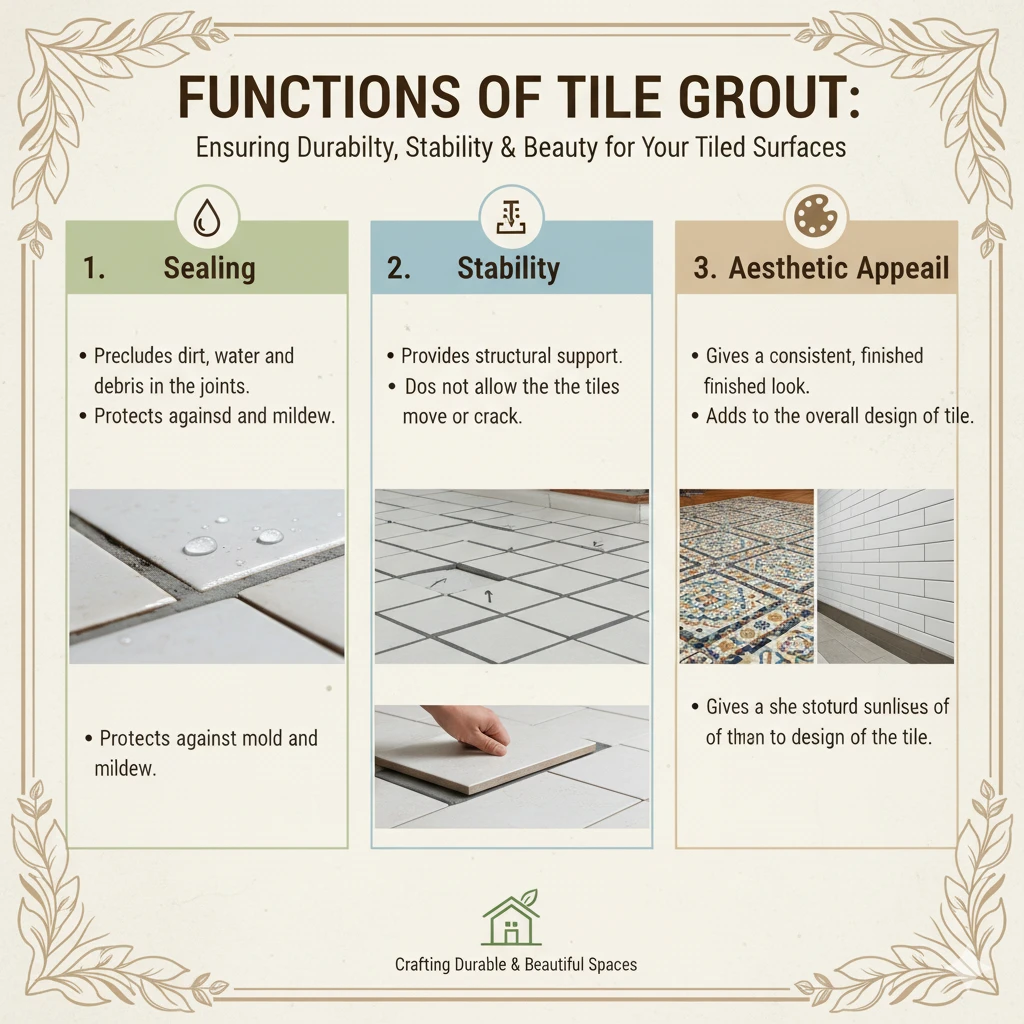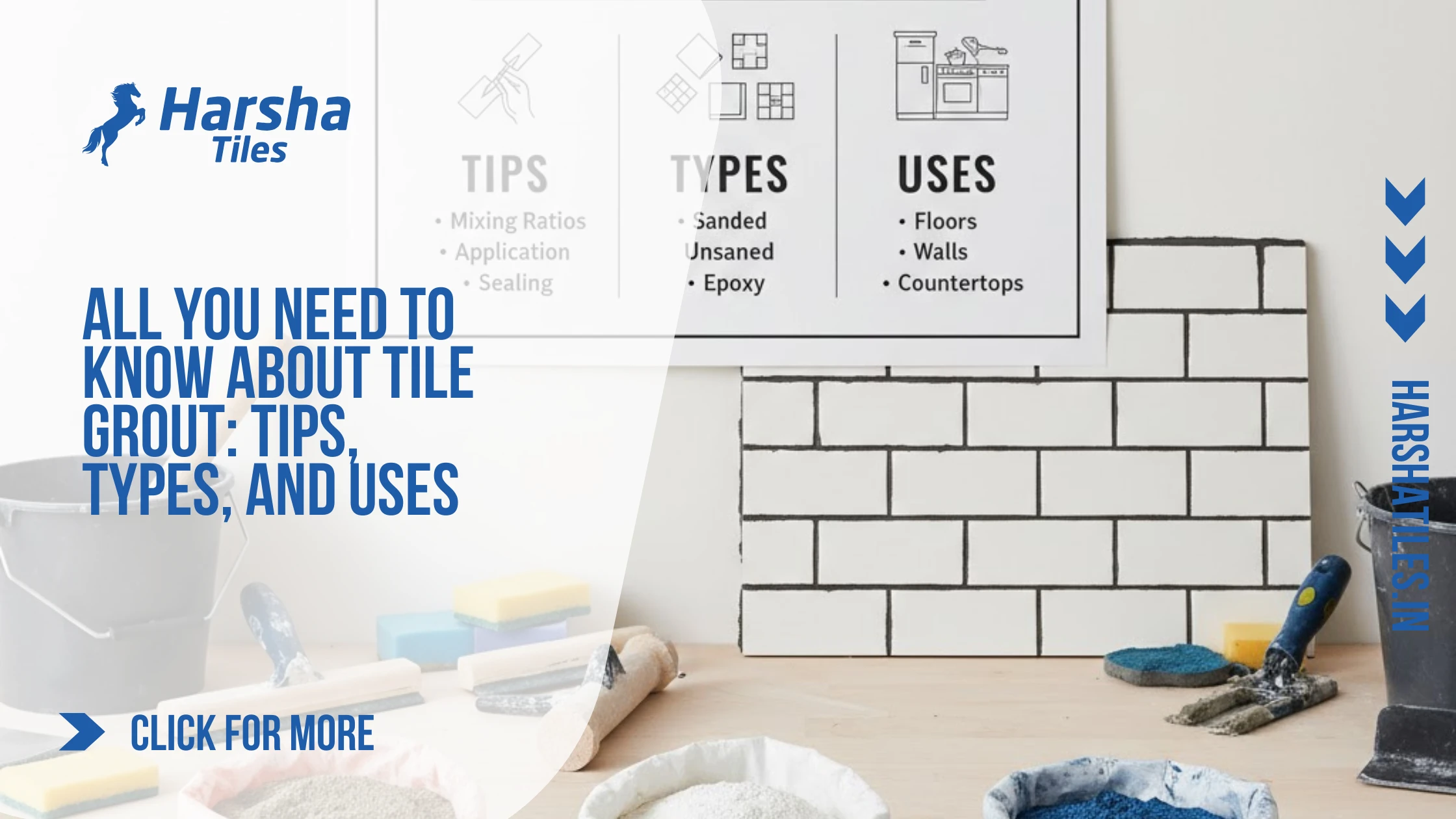Nov 09, 2025
Connect With Our Team
All You Need to Know About Tile Grout: Tips, Types, and Uses
- Home
- Utilities
- News & Blog
Most individuals tend to concentrate on the pattern, texture and design of the tiles used when installing tiles but little do they realize that what is keeping the tiles in place is a very important detail that is called tile grout. Grout is a relatively small finishing face but it actually contributes to the longevity, looks and cleanliness of tiled surfaces.
What Is Tile Grout?

Tile grout is a paste of fine texture that is applied into the cracks between the tiles once laid. It does not only give a completed appearance, but also eliminates the seepage of dirt, water and debris into the joints. Grout is normally cement, sand or epoxy to make sure that your tiles are firmly fastened and aligned.
Grout is used to fill the gaps between tiles unlike tile adhesive that attaches the tiles to the surface. It is often applied in bathrooms, kitchens, living rooms and outdoor patios, and the place where tiles are put.
Functions of Tile Grout:
-
Sealing: Precludes dirt, water and debris in the joints.
-
Stability: Does not allow the tiles to move or crack.
-
Aesthetic appeal: Gives a consistent look and adds to the design of the tile in general.
Why Is Tile Grout Important?
Grout may appear decorative, but its purpose extends far beyond looks:
Stability: It fixes the tiles so that they do not crack or loose.
Moisture protection: Grout is used in wet areas such as the bathroom to ensure that the water does not creep under tiles.
Easy cleaning: Smooth, filled joints decrease the presence of the dust and bacteria.
Aesthetic value: The aesthetic appeal of the grout (be it black grout, white grout or gold grout to tile) can radically transform the appearance of an area.
Floor tile grout, bathroom tile grout, and any other selection will have an effect on performance and design.
Types of Tile Grout

Choosing the right grout depends on where and how it’s used. Let’s explore the main types:
1. Cement-Based Grout
Cement-based type of grout is the most commonly used and it can be found in two forms:
Sanded Grout: This is a mixture of fine sand and it is used in joints greater than 1/8 inch. It is more stable and less shrinkable.
Unsanded Grout: Smooth and can be used in narrow joints or fragile tiles such as marble where the problem of scratching may arise.
2. Epoxy Tile Grout
Epoxy grout is a new and high performance product that is composed of epoxy resins and hardeners. It is also porcelain tiles, waterproof, and does not stain, therefore ideal in the bathrooms, kitchen, and outdoors. It is a little costlier, but it is the most durable with no need of sealing.
Advantages of White Epoxy Grout.
-
Does not fade away, is not yellow with time.
-
Inhibits absorption of water and mold.
-
Suitable in kitchens, bath rooms and swimming pools.
3. Polymer-Modified Grout
This kind of type is a combination of conventional cement grout, with polymer additives, that enhance flexibility, water resistance, and bond strength. It is a great option when it concerns floors, which can be subject to movement or change of temperature.
4. Furan Grout
Furan grout is chemically and heat resistant and is designed to drive in industrial spaces. Nonetheless, it is not that easy to install, which is why it is not as widespread as residential use.
5. Colored Grout
Aesthetic oriented house owners tend to use colour grout like grey grout, black tile grout, or even gold grout to blend or contrast with their tiles. An example is that white epoxy grout will match light tiles perfectly whereas darker colors will provide dimension and theatrics.
How Do You Choose the Right Grout for Your Project?
The choice of tile grout is based on a number of practical and environmental considerations. This is what you need to think about:
1. Bathroom Tile Grout
Bathrooms are subjected to continuous moisture, and epoxy grout can be used in this case because it is waterproof and does not promote the development of molds.
2. Floor Tile Grout
Polymer modified or sanded grout is also used when high foot traffic like living rooms or hallways are required and cracking is to be avoided.
3. Joint Width
-
Apply unsanded grout to joints less than 1/8 inch.
-
Use sanded grout where the joints are more than 1/8 inch.
-
The correct decision guarantees improved staffing and sustainability.
4. Climatic and Humidity Conditions.
Humid or tropical climates Epoxy or polymer-modified blends are types of grouts that are resistant to moisture, which makes them more effective and they need fewer maintenance.
What Are the Best Grout Colors for Your Tiles?

Grout color is another major factor in the tile design. The appropriate shade can either make your tiles blend like a carpet or contrast.
1. White Grout
White grout is classic and clean and suits light-colour tiles and provides a spacious and bright impression. Nonetheless, it can be easily washed, which can help avoid staining.
2. Black Grout & Black Tile Grout
Black grout is bold and elegant and provides a dramatic contrast to light tiles and conceals dirt. It works perfectly in kitchens, door frames and in commercial areas.
3. Grey Grout
A multi-purpose option that matches virtually with any tile color. Grey grout offers a moderate finish that balances the mechanism and the beauty.
4. Gold Grout and Gold Grout Tile.
To be fancy, gold grout can be used as an addition to glamour and sophistication particularly when it comes to marble or mosaic tiles. It is gaining popularity on contemporary walls and walls of accents.
5. Colored Grout Options
You can use colored grout to be creative and it may be matched or contrasted with the tiles to bring out a special aesthetic.
How to Choose the Right Tile Grout
Picking the best grout depends on multiple factors:
-
Tile type: Pairing tile with cement or epoxy grout: porcelain or ceramic tiles.
-
Installing space: Epoxy tile glue may be used in damp environments such as the bathroom or kitchen.
-
Design preference: For a uniform look, match grout color to your tile; for contrast, go bold with black grout or metallic shades like gold.
-
Durability requirements: Epoxy materials have maximum strength and durability.
How Should You Seal and Maintain Tile Grout?
Proper sealing and maintenance are essential to keep grout looking new and prevent damage over time.
1. Importance of Grout Sealer
Sealing grout creates a protective barrier that repels water, stains, and bacteria. It’s especially important for cement-based grouts, which are porous by nature.
An application of grout provides a protective layer that prevents water, stains, and bacteria. It is particularly significant to cement-based grouts that are porous in nature.
2. Tile Sealing Process
-
Wait 48–72 hours after grouting before sealing.
-
Apply a high-quality grout sealer evenly with a small brush or applicator.
-
Let it dry completely before exposing the area to water.
3. Maintenance Tips
-
Clean grout lines weekly with a mild, pH-neutral cleaner.
-
Avoid using bleach or harsh chemicals.
-
Address any cracks or gaps promptly to prevent moisture damage.
4. Re-Sealing Frequency
Reapply sealer every 6 to 12 months for cement-based grout. Epoxy grout typically doesn’t need sealing.
Conclusion
Whether it’s floor tile grout for living areas or epoxy tile grout for bathrooms, the right grout ensures your tiles look perfect and perform better over time. From choosing the right type to applying a grout sealer, every step enhances durability and design.
With options like white grout, black tile grout, or even gold grout for tile, homeowners can now turn functional joints into style statements. For best results, invest in high-quality grout materials and professional application your tiles deserve it.
At Harsha Tiles, we understand the importance of quality and precision in every aspect of tiling. Our extensive range of tiles and adhesives is designed to meet diverse needs, ensuring that your tiling projects are both beautiful and enduring.
Frequently Asked Questions About Tile Grout
1. What is the best grout for bathroom tiles?
Epoxy grout is the best for bathroom applications since it’s waterproof and resists mold and discoloration.
2. Can epoxy grout be used on all tiles?
Yes, but it’s most suitable for non-porous surfaces like ceramic or porcelain. For natural stones, sealing is recommended.
3. How long does grout last before resealing?
Typically, grout should be resealed every 1–2 years, depending on exposure to moisture and wear.
4. Is white epoxy grout better than cement grout?
Yes white epoxy grout offers better resistance to stains and cracking than cement grout, though it’s slightly costlier.
Latest Blogs
Got questions? Fill out the form and get in touch with us!
Harsha Tiles
21,22 Cowley Brown Road ,
R.S. Puram,Coimbatore – 641002.
2025 Harsha Tiles | Design And Managed By : LLS - INDIA
Whatsapp Chatx
Hi! Click one of our representatives below to chat on WhatsApp or send us email to info@harshatiles.in
 |
Mr Saleem +91 82702 80707 |
 |
Mr Martin +91 78688 86655 |

We will love to hear from you!


